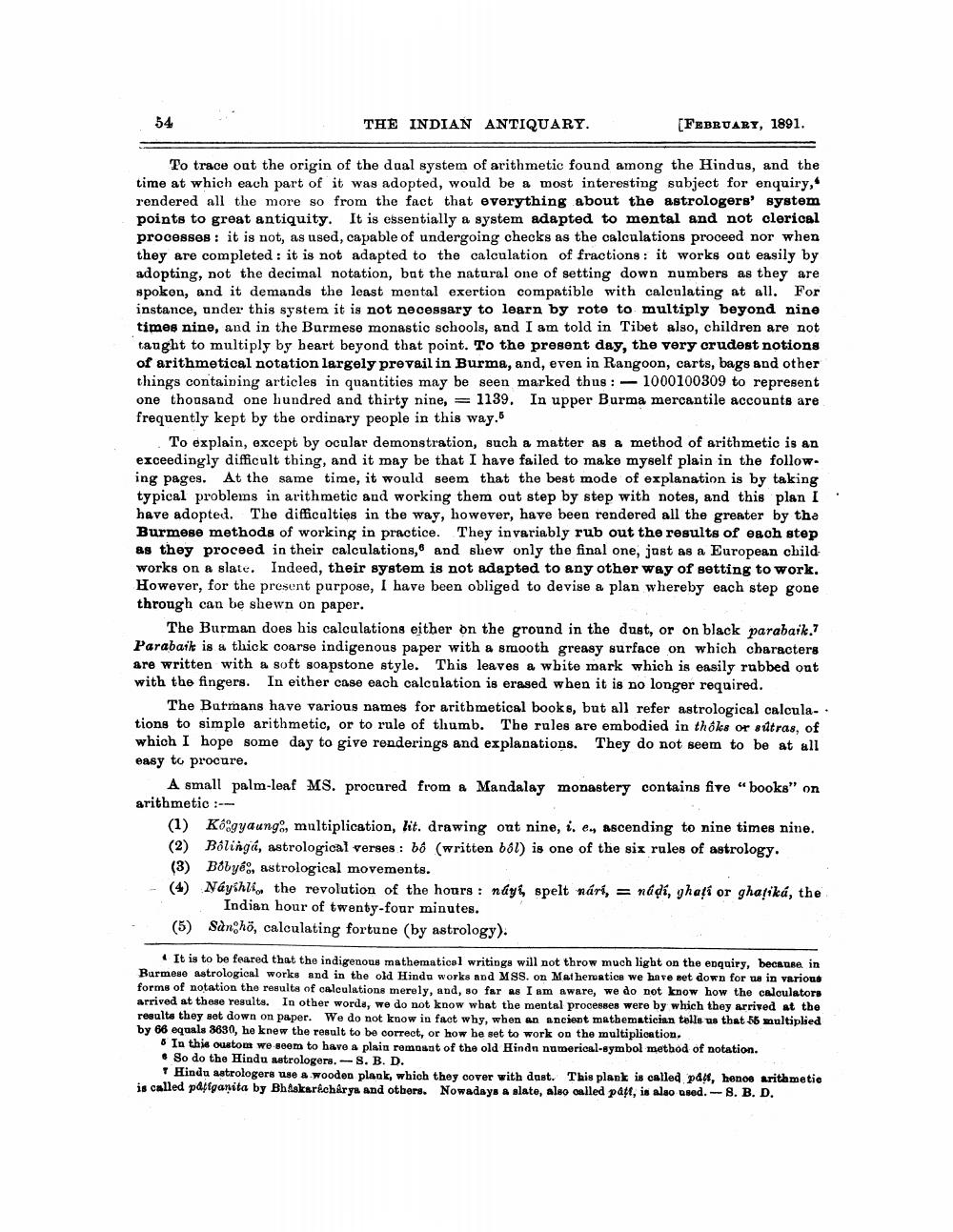________________
54
THE INDIAN ANTIQUARY.
[FEBRUARY, 1891.
To trace out the origin of the dual system of arithmetic found among the Hindus, and the time at which each part of it was adopted, would be a most interesting subject for enquiry, rendered all the more so from the fact that everything about the astrologers' system points to great antiquity. It is essentially a system adapted to mental and not clerical processes: it is not, as used, capable of undergoing checks as the calculations proceed nor when they are completed: it is not adapted to the calculation of fractions: it works out easily by adopting, not the decimal notation, but the natural one of setting down numbers as they are spoken, and it demands the least mental exertion compatible with calculating at all. For instance, under this system it is not necessary to learn by rote to multiply beyond nine times nine, and in the Burmese monastic schools, and I am told in Tibet also, children are not taught to multiply by heart beyond that point. To the present day, the very crudest notions of arithmetical notation largely prevail in Burma, and, even in Rangoon, carts, bags and other things containing articles in quantities may be seen marked thus: 1000100309 to represent one thousand one hundred and thirty nine, 1139. In upper Burma mercantile accounts are frequently kept by the ordinary people in this way.5
To explain, except by ocular demonstration, such a matter as a method of arithmetic is an exceedingly difficult thing, and it may be that I have failed to make myself plain in the following pages. At the same time, it would seem that the best mode of explanation is by taking typical problems in arithmetic and working them out step by step with notes, and this plan I have adopted. The difficulties in the way, however, have been rendered all the greater by the Burmese methods of working in practice. They invariably rub out the results of each step as they proceed in their calculations, and shew only the final one, just as a European childworks on a slate. Indeed, their system is not adapted to any other way of setting to work. However, for the present purpose, I have been obliged to devise a plan whereby each step gone through can be shewn on paper.
The Burman does his calculations either on the ground in the dust, or on black parabaik." Parabaik is a thick coarse indigenous paper with a smooth greasy surface on which characters are written with a soft soapstone style. This leaves a white mark which is easily rubbed out with the fingers. In either case each calculation is erased when it is no longer required.
The Burmans have various names for arithmetical books, but all refer astrological calcula-. tions to simple arithmetic, or to rule of thumb. The rules are embodied in thôks or sutras, of which I hope some day to give renderings and explanations. They do not seem to be at all easy to procure.
A small palm-leaf MS. procured from a Mandalay monastery contains five "books" on arithmetic :--
(1) Kogyaung, multiplication, lit. drawing out nine, i. e., ascending to nine times nine. (2) Bôlinga, astrological verses: bó (written ból) is one of the six rules of astrology.
(3) Boby, astrological movements.
(4) Náyihl the revolution of the hours: náy, spelt nári, nádi, ghati or ghatiká, the Indian hour of twenty-four minutes.
(5) Sancho, calculating fortune (by astrology).
It is to be feared that the indigenous mathematical writings will not throw much light on the enquiry, because in Burmese astrological works and in the old Hindu works and MSS. on Mathematics we have set down for us in various forms of notation the results of calculations merely, and, so far as I am aware, we do not know how the calculators arrived at these results. In other words, we do not know what the mental processes were by which they arrived at the results they set down on paper. We do not know in fact why, when an ancient mathematician tells us that 55 multiplied by 66 equals 3630, he knew the result to be correct, or how he set to work on the multiplication,
In this oustom we seem to have a plain remnant of the old Hindn numerical-symbol method of notation. So do the Hindu astrologers.-S. B. D.
Hindu astrologers use a wooden plank, which they cover with dust. This plank is called på, hence arithmetic is called patiganita by Bhaskaracharya and others. Nowadays a slate, also called pâtt, is also used.-S. B. D.




